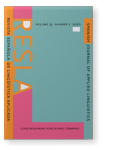Vol. 33:2 (2020) ► pp.384–415
Vol. 33:2 (2020) ► pp.384–415
Thinking for speaking in the right aspect
On whether modern English grammars can do more
In this article we focus on the category of aspect and examine modern English grammars to see whether they give sufficient guidelines to the learner on how aspectual meanings are decoded and encoded in English. More precisely, we check whether the grammars reflect the abundant linguistic research on aspectual construal in English. Out of a number of components that play a role in the shaping of aspectual meaning, we look at the following four: lexical aspect, arguments, grammatical aspect, and tense. An overview is first made of the key theoretical findings on the impact of these four components on aspectual interpretation, followed by an analysis of the grammar content on the given components. Our conclusion is that only two comprehensive grammars we examined take into account the results of linguistic research on aspect to a certain extent and that there is a lot of room for improvement.
Article outline
- 1.Introduction
- 2.
Literature on CA in English
- 2.1CA in linguistic theory
- 2.1.1Lexical aspect
- 2.1.2Arguments
- 2.1.3Grammatical aspect
- 2.1.4Tenses
- 2.2CA in the literature on second-language acquisition (‘SLA’)
- 2.1CA in linguistic theory
- 3.Grammars on CA in English
- 3.1Group one: Comprehensive grammars of English treating aspect as a tense/aspect category
- 3.2Group two: Comprehensive grammars of English addressing aspect more systematically
- 3.2.1Overall approach to aspect
- 3.2.2Lexical aspect
- 3.2.3Arguments
- 3.2.4Grammatical aspect
- 3.2.5Tenses
- 3.3Group three: Specialised grammars
- 4.Discussion
- 5.Conclusion
- Acknowledgements
- Notes
-
References
